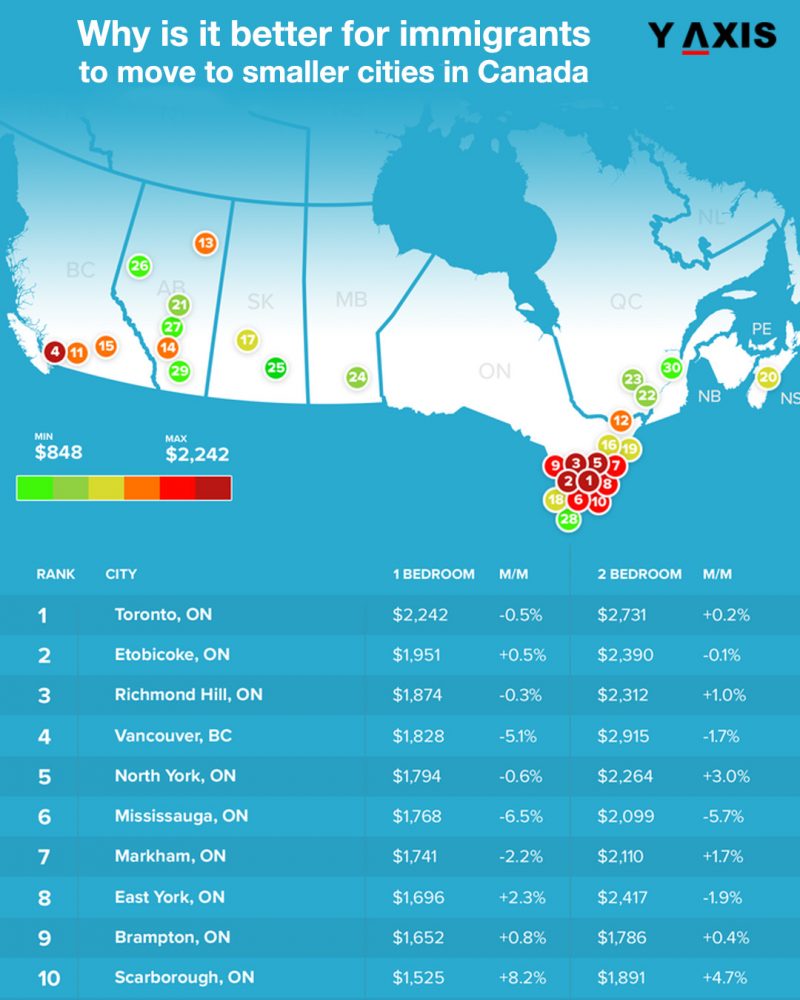Posted on February 08 2020
Why is it better for immigrants to move to smaller cities in Canada
By , Editor
Updated April 03 2023

Canada, since the past two decades, has been encouraging immigrants to move to the smaller cities. Smaller cities offer not only affordable housing and high quality of life but also very good job opportunities.
The Provincial Nominee Program of Canada has been instrumental in moving more immigrants to the smaller cities. A couple of decades back, almost 85% of all immigrants moved to the major provinces of Ontario, British Columbia and Quebec. This left other provinces in the country struggling with a labour shortage.
Canada launched the PNP in 1999. Since its inception, the PNP has managed to reduce the number of immigrants moving to the major provinces to 70%.
Canada has launched several programs to promote more immigration to smaller cities actively. Some of the recently launched programs are the Atlantic Immigration Pilot and the Rural and Northern Immigration Pilot.
Various provinces in Canada have also launched various programs to encourage more migrants to move outside the state capitals. For instance, Ontario plans to launch the Rural Immigration Pilot under the OINP in 2020. Nearly 80% of all immigrants to Ontario prefer to settle in the Greater Toronto Area. This means that many other cities in Ontario are left to struggle with a workforce shortage.
The main priority for immigrants when moving to Canada is to secure a job. Though immigrants are attracted to the economic prospects of the major Canadian cities, it is important that they know that there are excellent job opportunities available in the smaller cities as well. Smaller cities have a greater need for skilled workers. Hence, immigrants are bound to find better job opportunities in smaller cities.
The unemployment rate in Canada is 5.7% which has been historically low due to Canada’s ageing population and low birth rate.
The unemployment rates in the major cities of Canada are as follows:
- Toronto: 5.6%
- Montreal: 6%
- Calgary: 7.1%
- Vancouver: 4.8%
The unemployment rate of many smaller cities in Canada is much lower than the national average. Immigrants should bear this in mind while deciding on where to live in Canada.
Here are the unemployment rates of some of the smaller cities in Canada:
- Moncton, New Brunswick: 5.1%
- Quebec City, Quebec: 3.5%
- Sherbrooke, Quebec: 4.7%
- Trois-Rivieres, Quebec: 5.2%
- Ottawa-Gatineau, Ottawa/Quebec: 4.4%
- Hamilton, Ontario: 4.5%
- Catherines-Niagara, Ontario: 4.8%
- Kitchener-Cambridge-Waterloo, Ontario: 5.2%
- Brantford, Ontario: 3.8%
- Guelph, Ontario: 5.6%
- London, Ontario: 5.6%
- Barrie, Ontario: 3.8%
- Greater Sudbury, Ontario: 5.4%
- Thunder Bay, Ontario: 5%
- Winnipeg, Manitoba: 5.3%
- Saskatoon, Saskatchewan: 5.7%
- Kelowna, British Columbia: 4.2%
- Abbotsford-Mission, British Columbia: 4.9%
- Victoria, British Columbia: 3.4%
Smaller cities tend to have more competitive labour markets which mean that immigrants may find jobs faster in smaller cities than the major ones.
The cost of living is pretty high in cities like Toronto and Vancouver. For immigrants moving to Canada, housing is a major expense. An average two-bedroom apartment in Vancouver costs $1,800 while in Toronto it costs about $1,600, which is on the higher side.
In comparison, a two-bedroom apartment in Moncton costs $900 and $1,200 in Winnipeg. If you live in Saskatoon, you will need to pay $1,100 for a two-bedroom apartment while in Trois-Rivieres it will only cost you $600. Hence, even if you have a lower salary, living in smaller cities is much more affordable than the major ones.
Another advantage that smaller cities have over major cities is that the quality of life is better in smaller cities. The commute time is much lesser with shorter distances and lesser traffic. Many smaller cities offer similar recreational activities like bigger cities. Immigrants can choose an activity as per their preference.
Also, communities in smaller cities are closer and more tight-knit. Hence, building friendship becomes easier for immigrants feeling homesick in a foreign land.
Canada offers more than 80 immigration pathways, many of which encourage immigrants to move to smaller cities in the country.
If you are looking to Study, Work in Canada, Visit, Invest or Migrate to Canada, talk to Y-Axis, the World’s No.1 Immigration & Visa Company.
If you found this blog engaging, you may also like…
Tags:
Canada Immigration
Share
Options for you by Y-Axis
Get it on your mobile
Get News alerts
Contact Y-Axis

